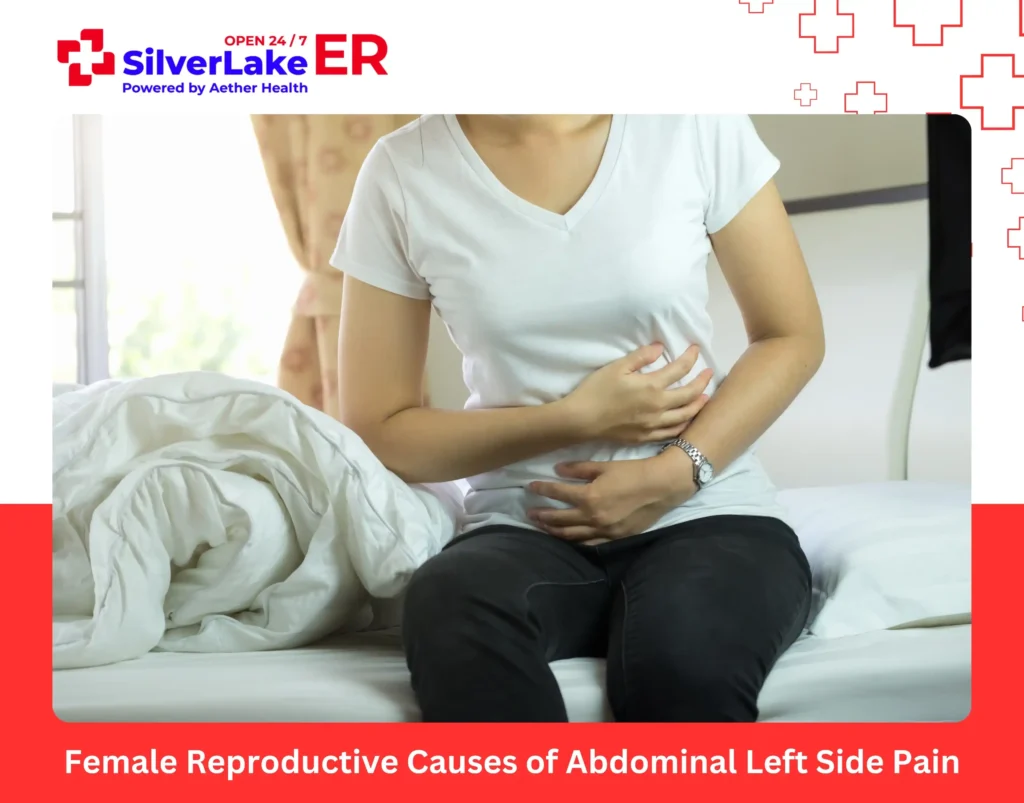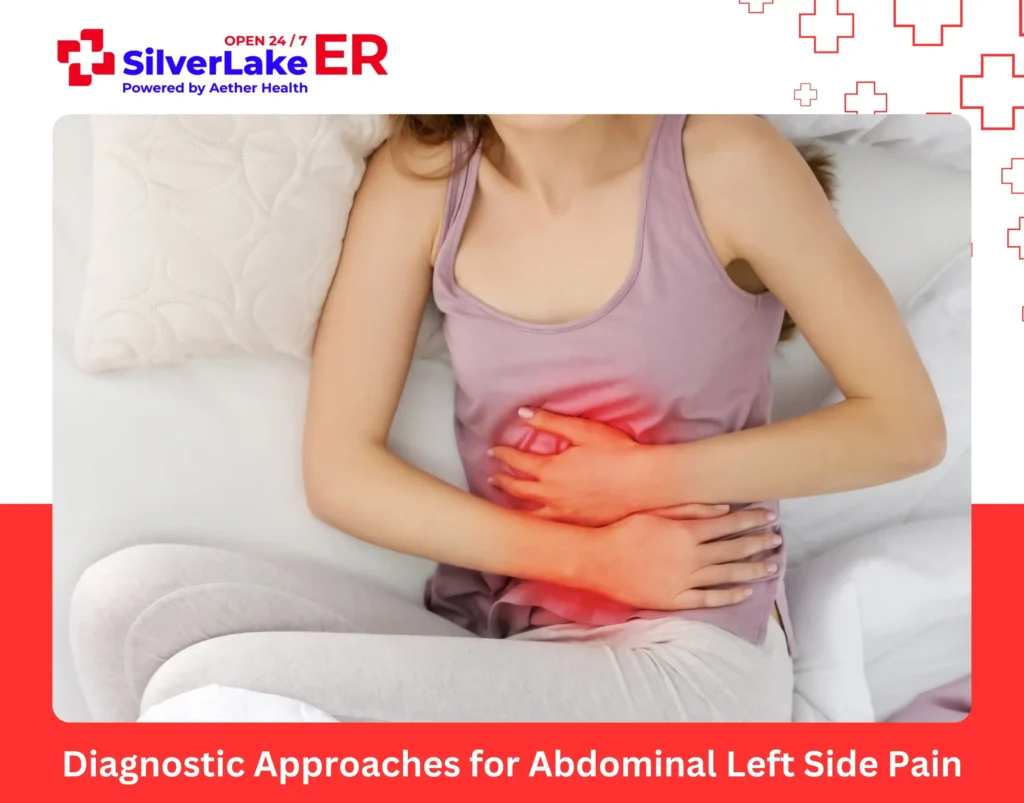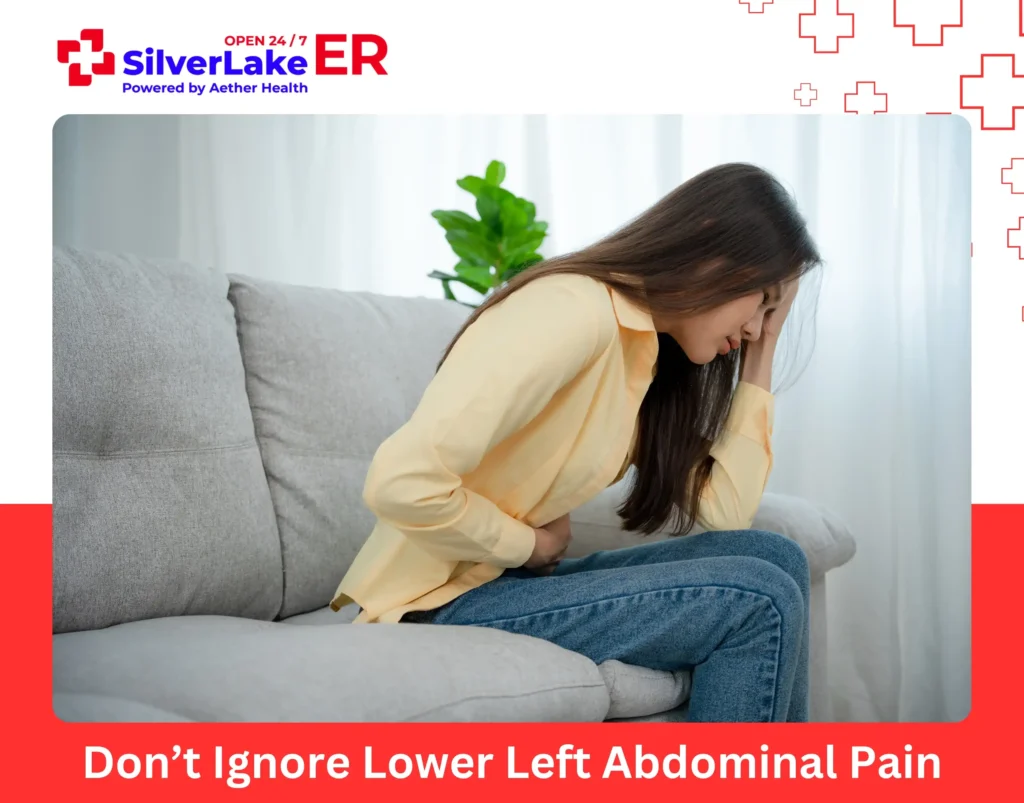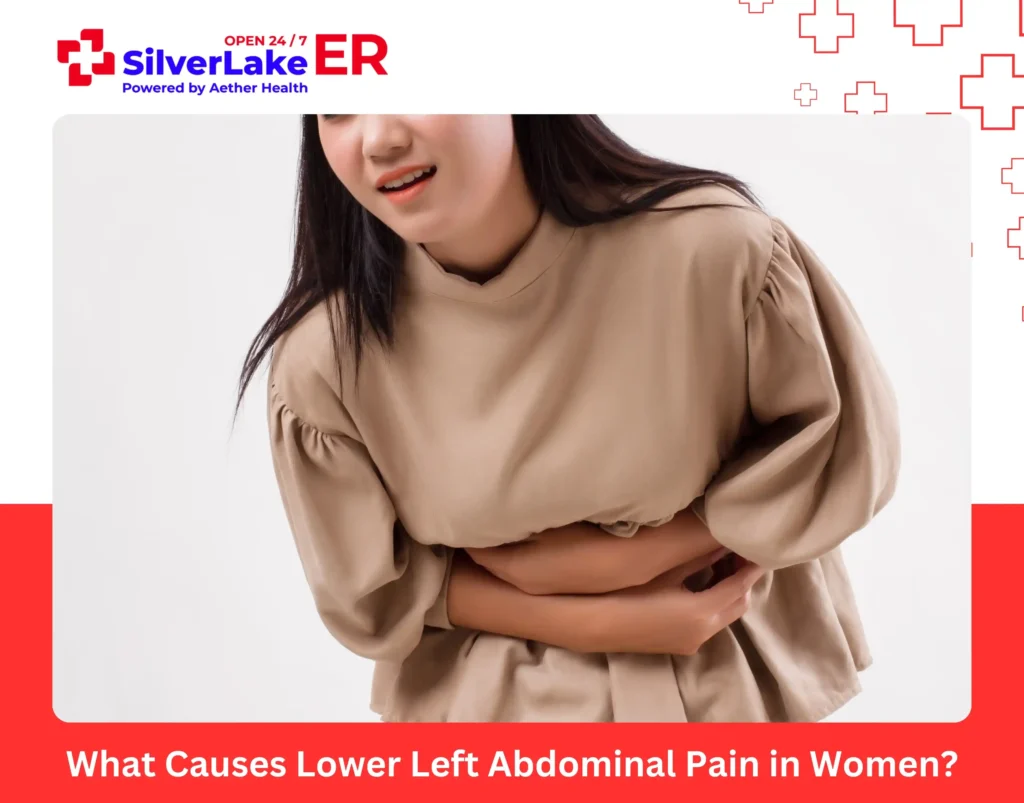Lower left abdominal pain affects an area that houses a mix of organs including the intestines, left ovary, fallopian tube, and surrounding muscles. Pain in this region can come from many possible sources.
The most common causes of lower left abdominal pain in women include intestinal gas, ovarian cysts, endometriosis, diverticulitis, kidney stones, UTIs, and muscle strains. Reproductive causes like ovarian cysts and endometriosis account for many cases in young women, while digestive issues such as diverticulitis become more common after age 40.
Each condition produces distinct pain patterns and accompanying symptoms. Sudden, severe pain demands immediate medical attention, particularly when coupled with fever, vomiting, or dizziness. These could be symptoms of serious conditions like ovarian torsion or ruptured cysts.
Let’s break down the most common causes of lower abdominal pain in women to help you identify what might be affecting you.
Female Reproductive Causes of Abdominal Left Side Pain

1. Ovarian Cysts and Complications
One of the most frequent answers to what causes lower left abdominal pain in females involves ovarian cysts. These fluid-filled sacs can develop on or within the ovaries and often cause no symptoms.
However, when cysts become large, rupture, or twist (ovarian torsion), they can produce severe lower left stomach pain. Functional cysts, including follicular and corpus luteum cysts, are particularly common and can cause sharp, stabbing pain that may worsen during certain activities or positions.
Ovarian torsion represents a gynecological emergency where the ovary twists on its supporting ligaments, cutting off blood supply. This condition typically causes sudden, severe pain in the lower abdomen that may radiate to the back or thigh. Women experiencing suspected ovarian torsion require immediate evaluation at an emergency facility.
Please Note: Cysts that form due to polycystic ovary syndrome (PCOS) are different from regular functional ovarian cysts. PCOS cysts are typically small, numerous, and hormonal in nature, and they don’t usually rupture or cause acute pain in the same way functional cysts can.
2. Endometriosis
Endometriosis affects over 11% of American women aged 15 to 44, and according to the WHO, an estimated 190 million women worldwide live with this condition¹.
Endometriosis occurs when tissue similar to the uterine lining grows outside the uterus, commonly affecting the ovaries, fallopian tubes, and pelvic lining. This condition causes lower left abdominal pain in women, particularly when endometrial implants develop on the left ovary or surrounding pelvic structures.
Research indicates that endometriosis is the cause of chronic pelvic pain in around 80% of women experiencing this symptom². The pain associated with endometriosis often intensifies during menstruation and may be accompanied by heavy bleeding, painful intercourse, and fertility issues.
3. Pelvic Inflammatory Disease (PID)
PID is a serious infection of the female reproductive organs, often caused by sexually transmitted bacteria. This condition can cause persistent lower abdominal pain on either side, including the lower left quadrant.
Pelvic Inflammatory Disease requires prompt antibiotic treatment to prevent complications such as abscess formation, chronic pelvic pain, and infertility. Women with PID may also experience fever, unusual vaginal discharge, and pain during urination or intercourse.
4. Ectopic Pregnancy
An ectopic pregnancy occurs when a fertilized egg implants outside the uterus, most commonly in the fallopian tubes. When the ectopic pregnancy develops in the left fallopian tube, it can cause severe lower left abdominal pain.
This condition represents a medical emergency because a ruptured ectopic pregnancy can cause life-threatening internal bleeding. Women of reproductive age should immediately see a doctor for severe abdominal pain, especially if accompanied by vaginal bleeding or dizziness.
5. Polycystic Ovary Syndrome (PCOS)
Polycystic ovary syndrome (PCOS) affects an estimated 6–13% of reproductive-aged women, yet up to 70% of cases remain undiagnosed worldwide.
This hormonal disorder leads to the development of multiple small ovarian cysts and can result in chronic pelvic or lower abdominal pain, often one-sided, including the lower left.
Pain may be dull or intermittent and can worsen around ovulation or menstruation. Other hallmark features of PCOS include irregular menstrual cycles, acne, excessive hair growth, weight gain, and infertility.
In some cases, enlarged ovaries from PCOS can mimic more urgent causes of stomach pain, requiring imaging to rule out complications like cyst rupture or torsion.
6. Mittelschmerz (Ovulation Pain)
This mid-cycle pain often occurs on one side of the lower abdomen, including the left, during ovulation. Though usually harmless, it can mimic more serious causes of abdominal pain and lead to unnecessary anxiety.
7. Uterine Fibroids
These noncancerous growths can develop on the left side of the uterus and produce pressure, cramping, or sharp pain in the lower abdomen. Some fibroids also cause abnormal menstrual bleeding and pelvic fullness.
8. Adenomyosis
Similar to endometriosis, adenomyosis involves endometrial tissue growing within the uterine muscle, leading to chronic pain, especially during menstruation, which may localize to one side.
Gastrointestinal Causes of Lower Left Abdominal Pain
1. Diverticulitis
Diverticulitis is a frequent cause of lower left abdominal pain in women, particularly those over 40. This condition involves inflammation of small pouches (diverticula) that can form in the colon wall.
When these pouches become infected or inflamed, they cause significant pain in the lower left abdomen. Diverticulitis may be accompanied by fever, nausea, vomiting, and changes in bowel habits. Severe cases can lead to complications such as abscesses, perforation, or intestinal obstruction.
2. Irritable Bowel Syndrome (IBS)
IBS represents a common functional gastrointestinal disorder that disproportionately affects women. Studies show that 11% of adults worldwide suffer from frequent meal-related abdominal pain, with women and younger individuals more commonly affected.
Irritable bowel syndrome can cause cramping pain throughout the abdomen, including the lower left quadrant. IBS-related pain often correlates with bowel movements and may be accompanied by bloating, gas, diarrhea, or constipation.
While not life-threatening, IBS can significantly impact quality of life and may require ongoing management.
3. Inflammatory Bowel Disease (IBD)
Crohn’s disease and ulcerative colitis, collectively known as IBD, can cause chronic inflammation of the digestive tract.
These conditions may explain what causes lower left abdominal pain in females when inflammation affects the left side of the colon.
IBD typically causes persistent abdominal pain, bloody diarrhea, weight loss, and fatigue. Unlike IBS, IBD represents a serious medical condition requiring specialized treatment.
4. Constipation and Fecal Impaction
Chronic constipation can lead to fecal impaction, particularly in the sigmoid colon located in the lower left abdomen. This condition can cause significant discomfort and cramping pain in the lower left abdominal region. While often manageable with dietary changes and laxatives, severe impaction may require medical intervention.
5. Colonic Cancer or Polyps
Although less common, colon cancer and large benign polyps may also present as chronic, dull left-sided abdominal pain, particularly in older women. A change in bowel habits or the presence of blood in stool may suggest a need for further evaluation.
Urological Causes
1. Kidney Stones
Kidney stones can cause excruciating pain that radiates from the back to the lower abdomen, including the lower left quadrant when the stone affects the left kidney or ureter.
This sharp, wave-like pain often accompanies nausea, vomiting, and blood in the urine. Large stones or those causing complete obstruction may require emergency intervention.
2. Urinary Tract Infections (UTIs)
While UTIs more commonly cause suprapubic pain, severe infections can produce lower abdominal discomfort, including in the left lower quadrant.
Complicated UTIs or those involving the left kidney (pyelonephritis) can cause significant left-sided abdominal and back pain, fever, and systemic symptoms.
3. Interstitial Cystitis (Painful Bladder Syndrome)
A chronic condition that can cause persistent pelvic or lower abdominal pain along with urinary urgency and frequency, especially in women. Pain may be worse with a full bladder or during menstruation.
Musculoskeletal Causes
1. Muscle Strain and Hernias
Physical activity, heavy lifting, or sudden movements can cause muscle strains in the abdominal wall, producing localized pain in the lower left abdomen.
Additionally, hernias, particularly inguinal or femoral hernias, can cause pain and swelling in the lower abdominal region.
While often manageable conservatively, incarcerated or strangulated hernias represent surgical emergencies.
2. Pelvic Floor Dysfunction
Weakness, tension, or injury to the pelvic floor muscles can result in referred pain in the lower abdomen, sometimes mistaken for gastrointestinal or gynecological issues. Women with a history of childbirth or chronic constipation are especially at risk.
When Should You See a Doctor for Lower Left Abdominal Pain?
Certain symptoms of lower left abdominal pain indicate a medical emergency. See a doctor if you experience:
- Sudden, severe stomach pain that prevents normal activities
- Pain accompanied by high fever (over 101°F)
- Persistent vomiting preventing fluid intake
- Signs of internal bleeding, including dizziness, rapid heartbeat, or fainting
- Severe pain during pregnancy or suspected pregnancy
- Abdominal pain with rigid, board-like abdomen
- Pain accompanied by inability to urinate or severe urinary symptoms
- Sudden onset of severe pain with rapid deterioration
These symptoms may indicate serious conditions such as appendicitis, ovarian torsion, ruptured ectopic pregnancy, or bowel perforation that require immediate surgical intervention.
Diagnostic Approaches for Abdominal Left Side Pain

While many women delay visits to their gynecologist, especially when symptoms are mild or come and go, it’s important not to ignore persistent or worsening pelvic pain. At SilverLake ER, our team takes a thorough and timely approach to uncover the cause of lower left abdominal pain through:
- A detailed medical history and physical examination, focusing on pain location, duration, intensity, menstrual history, and potential triggers.
- Laboratory testing, including blood work to check for infection, inflammation, or pregnancy, and urinalysis to detect urinary tract infections or kidney stones.
- Imaging studies such as ultrasound (including transvaginal for gynecologic concerns) and CT scans for abdominal and pelvic evaluation. The physician may also recommend an off-site MRI when more detailed imaging is needed.
- A pelvic examination to assess reproductive organs for signs of infection, masses, or tenderness.
- Diagnostic laparoscopy in cases where noninvasive methods are inconclusive or when direct visualization is necessary for diagnosis and treatment
This step-by-step approach ensures accurate diagnosis while addressing both urgent and underlying conditions efficiently.
Prevention and Long-term Management of Lower Left Abdominal Pain
While not all causes of lower left abdominal pain in females are preventable, certain lifestyle modifications can reduce risk. Regular gynecological examinations help detect conditions like ovarian cysts or endometriosis early. Maintaining good bowel health through adequate fiber intake and hydration can prevent many gastrointestinal causes of stomach pain.
Safe sexual practices reduce the risk of sexually transmitted infections that can lead to PID. Regular exercise and proper body mechanics during physical activities can prevent musculoskeletal causes of abdominal pain.
Don’t Ignore Lower Left Abdominal Pain

As a woman, it’s easy to dismiss lower abdominal pain as period cramps, especially when it overlaps with your menstrual cycle or stress. But persistent or sharp pain in the abdominal pain on the left side of the body can signal serious conditions.
If you or a loved one are experiencing lower left abdominal pain, seek medical treatment at the Aether Health – SilverLake ER. Our emergency facility is fully equipped with expert medical staffing and hospital-grade equipment, including on-site lab and ER imaging, to help identify the possible causes of your left lower abdominal pain within minutes.
We’re available 24/7 to provide effective urgent care treatment for left side abdominal pain without the long wait times of typical ERs.
FAQs
1. How do I know if my side pain is serious?
If the pain is sharp, sudden, persistent, worsens with movement, or comes with nausea, fever, or vomiting, seek immediate medical help.
2. How to tell if side pain is muscular or internal?
Muscular pain usually worsens with movement or pressure and improves with rest. Internal pain tends to be deeper, constant, and may include symptoms like bloating or fever.
3. What does hernia pain feel like?
Hernia pain feels like a dull ache or pressure that can become sharp during lifting, coughing, or straining, often near a visible or tender bulge.
4. What does ovarian cyst pain feel like?
Ovarian cyst pain often feels like a dull or sharp ache on one side of the lower abdomen that may come and go. A sudden sharp pain may suggest rupture or torsion.
5. What am I feeling in my lower abdomen?
Sensation in your lower abdominal could be related to digestion, reproductive organs, muscles, or the urinary tract. The nature, timing, and triggers of the pain help identify the cause.
6. Why is my lower abdomen hurting but no period?
Possible causes include ovarian cysts, endometriosis, IBS, UTI, or early pregnancy complications. It’s best to get evaluated if the pain persists or worsens.
7. Does ibuprofen help with lower abdomen pain?
Yes, ibuprofen can relieve inflammation-related pain like cramps, cysts, or muscular strain, but it may not help with internal medical conditions.
8. What does endometriosis in the abdomen feel like?
Endometriosis often causes deep, cramping pain that intensifies during menstruation, intercourse, bowel movements, or ovulation.
9. What does abdominal pain from ectopic pregnancy feel like?
Ectopic pregnancy causes sharp, stabbing pain on one side of the abdomen and may include vaginal bleeding, shoulder pain, or dizziness. This requires emergency care.
10. What does ovary torsion pain feel like?
Ovarian torsion brings sudden and intense pain on one side of the lower abdomen, often with nausea and vomiting. Immediate medical attention is needed.




